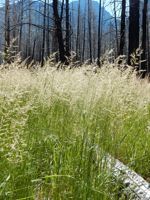Mon-Fri 9am - 5pm Mountain time
Bluejoint vs Hairy Golden Aster
Calamagrostis canadensis
Heterotheca villosa
CUSTOM GROW
NOT AVAILABLE THIS SEASON - MIGHT RETURN
Bluejoint is a native perennial grass that forms tall, dense colonies. It is one of the most abundant grasses found in Canada and the United States. The extensive shallow root system and spreading rhizomes help stabilise soils, especially in wet meadows, marshes, and along streambanks.
It is a cool-season grass, growing most actively in spring and fall and slowing during the heat of summer. Seeds from its purple-tinged spikes feed birds and small mammals, and the plant itself provides forage for wildlife and livestock, though it does not tolerate heavy grazing. Its tall, dense growth also offers nesting habitat for wetland birds. With these combined values, Bluejoint is well-suited for naturalisation, riparian plantings, and habitat restoration projects.
Hairy Golden Aster is a native perennial wildflower known for its clusters of bright yellow, daisy-like blooms. They bloom from mid-summer into fall, providing late-season colour and a valuable nectar source for pollinators, including a variety of bee species.
Flowers mature into fluffy seed heads and can self-seed readily. Removing spent blooms helps manage their spread, but some people will choose to leave a few seed heads to provide food for birds. Hairy Golden Aster grow in bushy clumps, tolerates poor sandy soils, and once established, are among the most drought-tolerant wildflowers. They are well-suited for pollinator gardens, restoration, naturalization, and xeriscaping projects.

